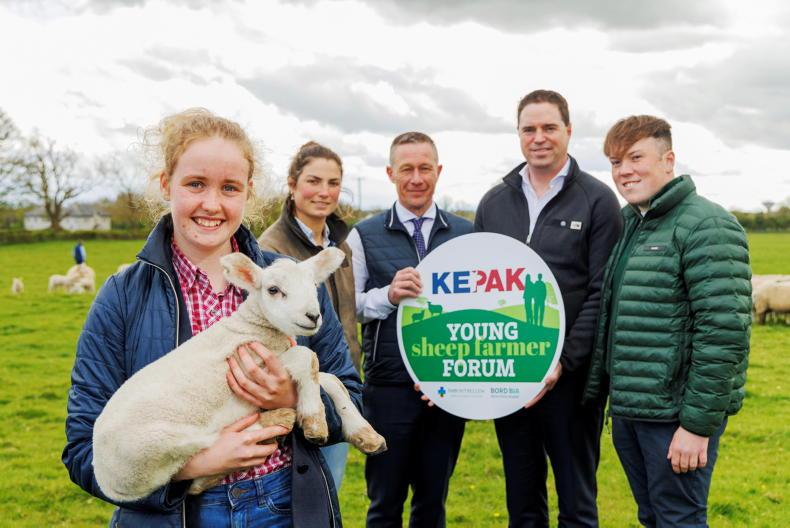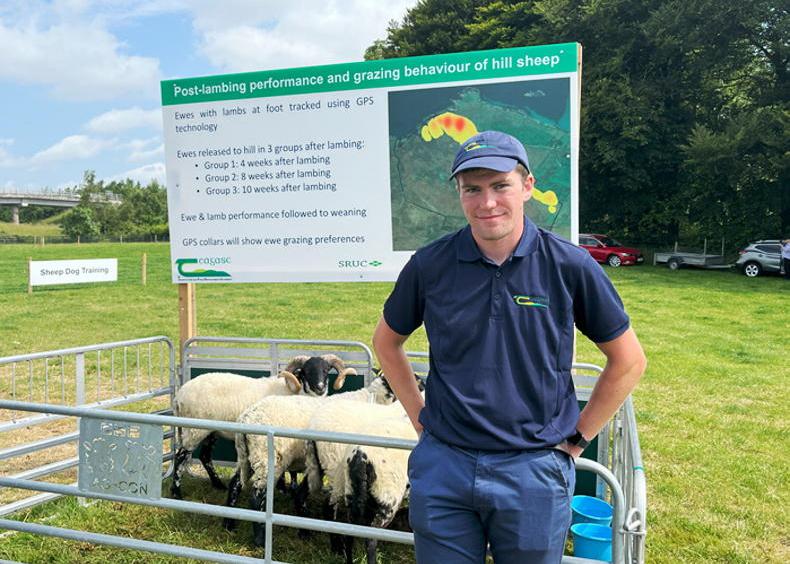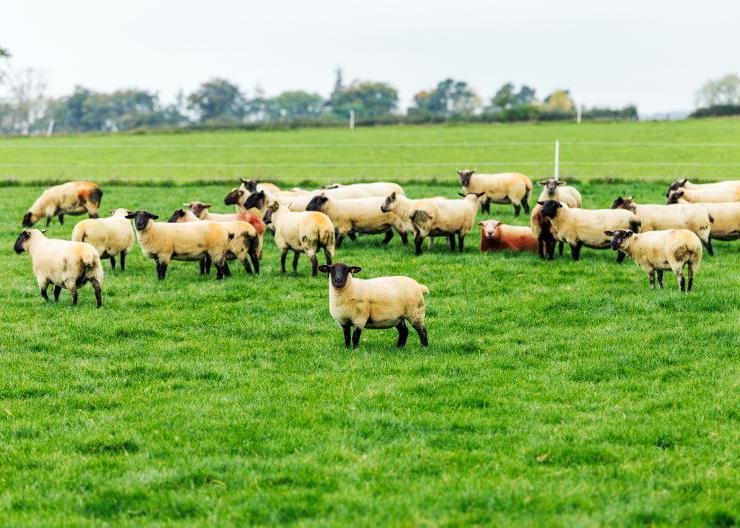David and Linda McLaughlin farm just outside Greencastle in Co Donegal and have been participating in the Teagasc BETTER Farm sheep programme since 2009, running both lowland and hill sheep enterprises alongside a herd of suckler cows. This year marks the end of David and Linda’s time in the programme and is a good chance to look at some of the key elements of their farming system.

David McLaughlin, Greencastle. \ Clive Wasson
Farm layout
The farm is laid out into three main blocks comprising 8.5 adjusted hectares of lowland at the home farm which joins the 155ha of enclosed hill land (adjusted to 31ha). There is also an additional 17 adjusted hectares of leased lowland ground which is used for the lowland sheep flock and cattle for most of the grazing season. The hill flock is made up of 250 purebred Lanark ewes which lamb outdoors from 5 April, with the lowland flock lambing indoors from 10 March. The lowland flock comprises approximately 110 ewes, with 80 Belclare-cross Lanark ewes running alongside 30 Lanark ewes, which have been culled from the hill flock but are still suitable to perform on lowland ground.
Defined farm plan key to
improving farm performance
As with all the Teagasc BETTER sheep farms, one of the first things done on the McLaughlin farm was to develop a detailed plan specific to the farm. Having a plan that works for the farm and is monitored against on-farm performance is essential for any farm to develop.

This year at weaning time (14 weeks of age) the single-born lambs had an average liveweight of 27.9kg and had grown at 234g/day from birth to weaning. \ Clive Wasson
The McLaughlins’ farm plan was based around three key elements: a defined breeding policy for both the lowland and hill flocks, grassland management, and setting up lowland and hill flocks to complement each other and maximise efficiencies on the farm.
Setting up both lowland and hill flocks to complement each other meant lambing the lowland flock from mid-March, with the aim of having most of these ewes lambed before the hill ewes began lambing from 5 April. This also meant having defined grazing areas for both flocks, ie the green ground for the hill flock was not used by the lowland ewes, etc, which allowed stocking rates to be maximised and ensure hill ewes grazed the hill for as much of the year as possible.
Integrated breeding policy
A major component of the McLaughlins’ farm plan was designing a breeding policy to allow the hill flock to produce sufficient replacement ewe lambs for both the hill and lowland flocks. In order for this system to work, a high level of performance is required from the hill flock to allow a portion of the ewes to be crossbred.

Hill ewes typically spend up to nine months of the year on the hill with enclosed ground used for grazing hill ewes pre-mating, pre- and post-lambing, and for lambs post-weaning.
On the McLaughlin farm, a Belclare ram is bred to approximately 25% of the hill ewes with the remainder of the ewes being bred to Lanark rams.
This system allows all the lambs born on the lowland flock (higher-value lambs compared to the hill lambs) to be sold either as factory lambs or breeding ewe lambs. Keeping 30 Lanark ewes for one final crop of lambs on the lowland also allows the McLaughlins to breed mule ewe lambs as part of the Donegal Mule group, which adds further value to the lamb crop.
Grassland management
Ewe numbers have increased on the farm over the years, while also maintaining the same land base which is a result of increasing grass production through improving soil fertility and grassland management. At this time of the year, the McLaughlins have most of the lowland grazing area closed following the autumn closing plan.

David McLaughlin pictured in 2019 explaining his system to a farm discussion group. David and Linda have been excellent advocates for the programme and disseminating technical advice.
Closing began this year on 25 October and will be completed in early January. The farm cover on 10 December was 423kg DM/ha, which is on target for a March-lambing flock. The McLaughlins are also firm believers in applying nitrogen early in the spring once conditions are right.
The grazing area for the hill flock is carefully managed. Typically, the ewes spend up to nine months of the year on the hill, with enclosed ground used for grazing hill ewes pre-mating, pre- and post-lambing, and for lambs post-weaning.
Hill ewes are not housed, except in unusual circumstances and are generally not fed silage/hay but are offered feed blocks and concentrates at times during the winter and in the lead-up to lambing.
Improved green ground areas are rested for ewes at lambing and ewes with a single lamb return to the hill around mid-May, while the twins rotate around green ground areas until weaning when replacement ewe lambs go back to the hill. The area vacated by the ewes with single lambs is cut for silage for the suckler herd, etc, in early to mid-July.
Flock performance
A key measure of any farming system is the animal performance seen on the farm and the McLaughlin flock performance over the years has been excellent (see Table 1).
The McLaughlins’ hill flock is consistently achieving high weaning rates and they have improved this significantly during their time as members of the BETTER Farm programme.
Lamb performance has also been consistently on or above target for a hill flock. This year at weaning time (14 weeks of age), the single-born lambs had an average liveweight of 27.9kg and had grown at 234g/day from birth to weaning.
The lowland flock is also achieving high levels of performance and the prolificacy and weaning rates have been improved and maintained over the past 10 years, as presented in Table 2.
All the Belclare-cross ewes are mated to a Texel ram, while the Lanark ewes taken from the hill flock are bred to a Blue Leicester ram to breed Mule ewe lambs for selling. In 2020, the twin lambs from the lowland flock were on average 32.4kg at weaning and had an average daily gain to weaning of 280g/day. This is a good level of performance from a grass- based system and from a flock that has approximately 30% purebred hill ewes included in it.
Conclusion
Having a defined farm plan that is tailored to the farm and is benchmarked against farm performance is essential to maximising the performance of any farm. The McLaughlins have shown this during their time in the Teagasc BETTER Farm sheep programme and the impressive performance of both their hill and lowland flocks is evidence of this.
Financial performance
A yearly eProfit monitor has been a key marker of how the improvements made on the McLaughlin farm have been affecting the gross margin achieved and, ultimately, if the changes to the system were working.
As part of the programme, the profit monitor has been assessed as whole-farm performance and also divided to give separate figures for the lowland and hill flocks.
Table 3 shows the gross margin from the lowland ewes has increased from €35.17/ewe to €87.68/ewe, while the gross margin per ewe from the hill ewes has increased from €13.01 to €49.70 per ewe. This is excellent financial performance from both flocks. While improve prices, have played a part in this improvement, the main driver has been improved flock performance.
David and Linda McLaughlin farm just outside Greencastle in Co Donegal and have been participating in the Teagasc BETTER Farm sheep programme since 2009, running both lowland and hill sheep enterprises alongside a herd of suckler cows. This year marks the end of David and Linda’s time in the programme and is a good chance to look at some of the key elements of their farming system.

David McLaughlin, Greencastle. \ Clive Wasson
Farm layout
The farm is laid out into three main blocks comprising 8.5 adjusted hectares of lowland at the home farm which joins the 155ha of enclosed hill land (adjusted to 31ha). There is also an additional 17 adjusted hectares of leased lowland ground which is used for the lowland sheep flock and cattle for most of the grazing season. The hill flock is made up of 250 purebred Lanark ewes which lamb outdoors from 5 April, with the lowland flock lambing indoors from 10 March. The lowland flock comprises approximately 110 ewes, with 80 Belclare-cross Lanark ewes running alongside 30 Lanark ewes, which have been culled from the hill flock but are still suitable to perform on lowland ground.
Defined farm plan key to
improving farm performance
As with all the Teagasc BETTER sheep farms, one of the first things done on the McLaughlin farm was to develop a detailed plan specific to the farm. Having a plan that works for the farm and is monitored against on-farm performance is essential for any farm to develop.

This year at weaning time (14 weeks of age) the single-born lambs had an average liveweight of 27.9kg and had grown at 234g/day from birth to weaning. \ Clive Wasson
The McLaughlins’ farm plan was based around three key elements: a defined breeding policy for both the lowland and hill flocks, grassland management, and setting up lowland and hill flocks to complement each other and maximise efficiencies on the farm.
Setting up both lowland and hill flocks to complement each other meant lambing the lowland flock from mid-March, with the aim of having most of these ewes lambed before the hill ewes began lambing from 5 April. This also meant having defined grazing areas for both flocks, ie the green ground for the hill flock was not used by the lowland ewes, etc, which allowed stocking rates to be maximised and ensure hill ewes grazed the hill for as much of the year as possible.
Integrated breeding policy
A major component of the McLaughlins’ farm plan was designing a breeding policy to allow the hill flock to produce sufficient replacement ewe lambs for both the hill and lowland flocks. In order for this system to work, a high level of performance is required from the hill flock to allow a portion of the ewes to be crossbred.

Hill ewes typically spend up to nine months of the year on the hill with enclosed ground used for grazing hill ewes pre-mating, pre- and post-lambing, and for lambs post-weaning.
On the McLaughlin farm, a Belclare ram is bred to approximately 25% of the hill ewes with the remainder of the ewes being bred to Lanark rams.
This system allows all the lambs born on the lowland flock (higher-value lambs compared to the hill lambs) to be sold either as factory lambs or breeding ewe lambs. Keeping 30 Lanark ewes for one final crop of lambs on the lowland also allows the McLaughlins to breed mule ewe lambs as part of the Donegal Mule group, which adds further value to the lamb crop.
Grassland management
Ewe numbers have increased on the farm over the years, while also maintaining the same land base which is a result of increasing grass production through improving soil fertility and grassland management. At this time of the year, the McLaughlins have most of the lowland grazing area closed following the autumn closing plan.

David McLaughlin pictured in 2019 explaining his system to a farm discussion group. David and Linda have been excellent advocates for the programme and disseminating technical advice.
Closing began this year on 25 October and will be completed in early January. The farm cover on 10 December was 423kg DM/ha, which is on target for a March-lambing flock. The McLaughlins are also firm believers in applying nitrogen early in the spring once conditions are right.
The grazing area for the hill flock is carefully managed. Typically, the ewes spend up to nine months of the year on the hill, with enclosed ground used for grazing hill ewes pre-mating, pre- and post-lambing, and for lambs post-weaning.
Hill ewes are not housed, except in unusual circumstances and are generally not fed silage/hay but are offered feed blocks and concentrates at times during the winter and in the lead-up to lambing.
Improved green ground areas are rested for ewes at lambing and ewes with a single lamb return to the hill around mid-May, while the twins rotate around green ground areas until weaning when replacement ewe lambs go back to the hill. The area vacated by the ewes with single lambs is cut for silage for the suckler herd, etc, in early to mid-July.
Flock performance
A key measure of any farming system is the animal performance seen on the farm and the McLaughlin flock performance over the years has been excellent (see Table 1).
The McLaughlins’ hill flock is consistently achieving high weaning rates and they have improved this significantly during their time as members of the BETTER Farm programme.
Lamb performance has also been consistently on or above target for a hill flock. This year at weaning time (14 weeks of age), the single-born lambs had an average liveweight of 27.9kg and had grown at 234g/day from birth to weaning.
The lowland flock is also achieving high levels of performance and the prolificacy and weaning rates have been improved and maintained over the past 10 years, as presented in Table 2.
All the Belclare-cross ewes are mated to a Texel ram, while the Lanark ewes taken from the hill flock are bred to a Blue Leicester ram to breed Mule ewe lambs for selling. In 2020, the twin lambs from the lowland flock were on average 32.4kg at weaning and had an average daily gain to weaning of 280g/day. This is a good level of performance from a grass- based system and from a flock that has approximately 30% purebred hill ewes included in it.
Conclusion
Having a defined farm plan that is tailored to the farm and is benchmarked against farm performance is essential to maximising the performance of any farm. The McLaughlins have shown this during their time in the Teagasc BETTER Farm sheep programme and the impressive performance of both their hill and lowland flocks is evidence of this.
Financial performance
A yearly eProfit monitor has been a key marker of how the improvements made on the McLaughlin farm have been affecting the gross margin achieved and, ultimately, if the changes to the system were working.
As part of the programme, the profit monitor has been assessed as whole-farm performance and also divided to give separate figures for the lowland and hill flocks.
Table 3 shows the gross margin from the lowland ewes has increased from €35.17/ewe to €87.68/ewe, while the gross margin per ewe from the hill ewes has increased from €13.01 to €49.70 per ewe. This is excellent financial performance from both flocks. While improve prices, have played a part in this improvement, the main driver has been improved flock performance.














SHARING OPTIONS